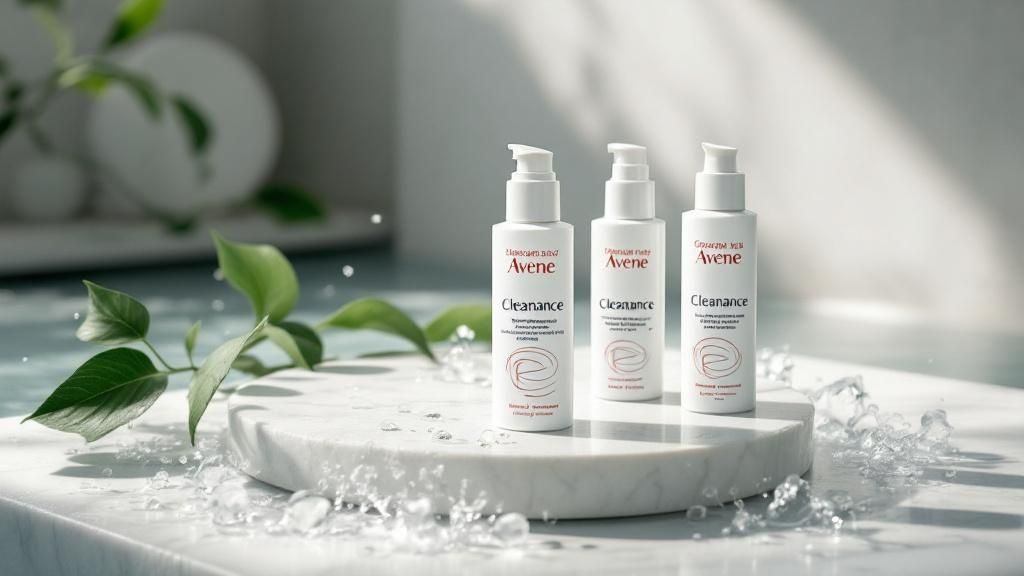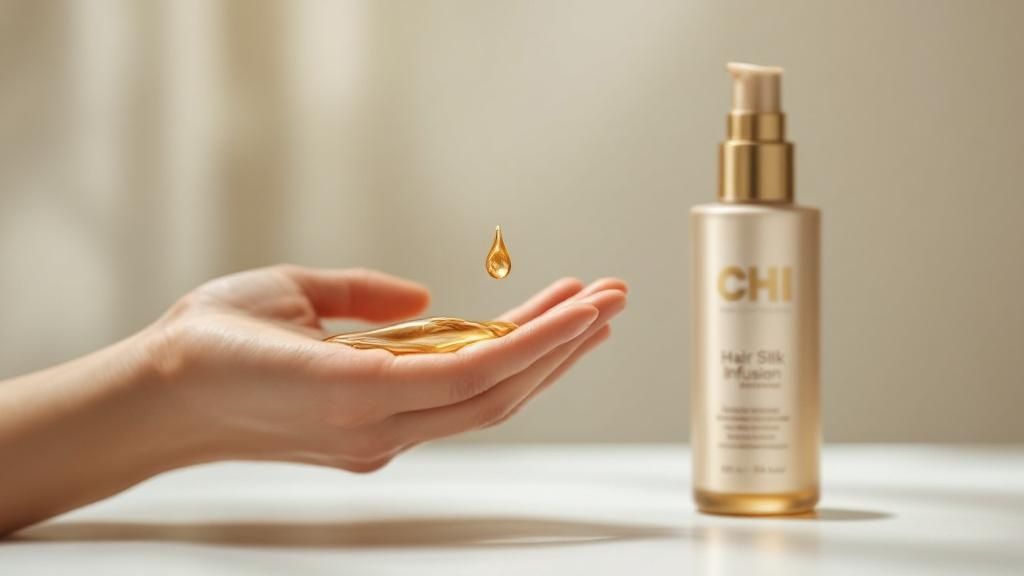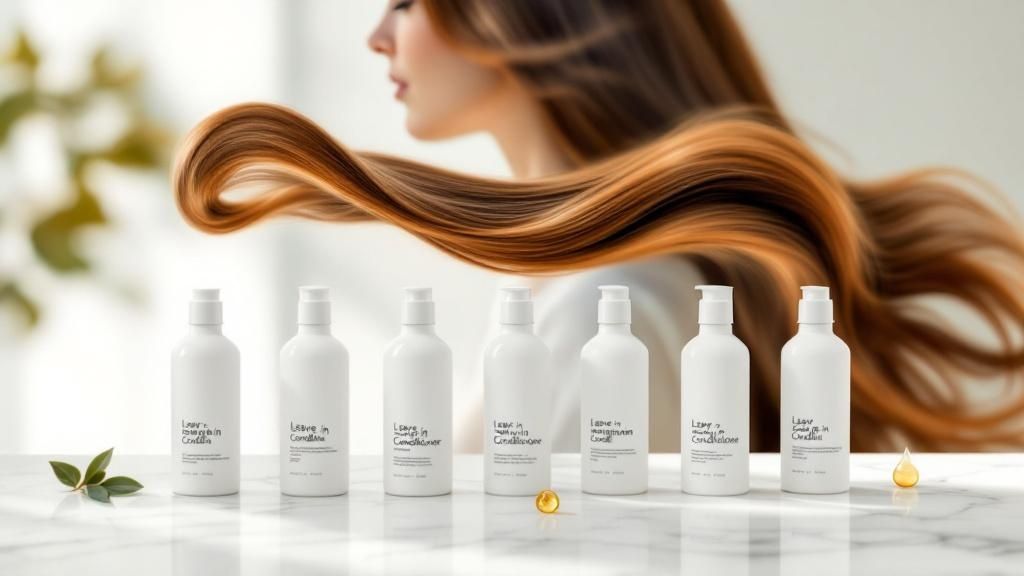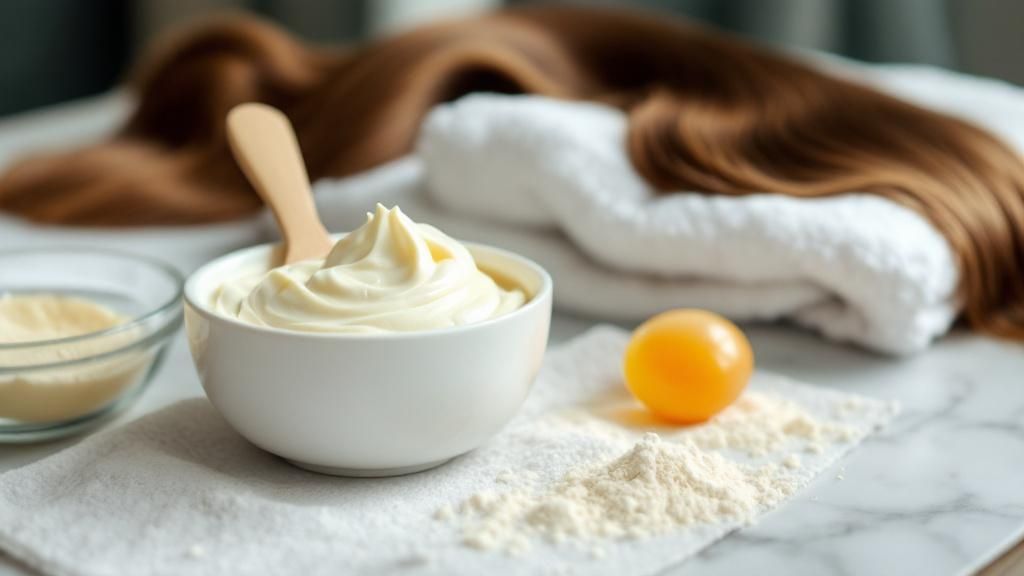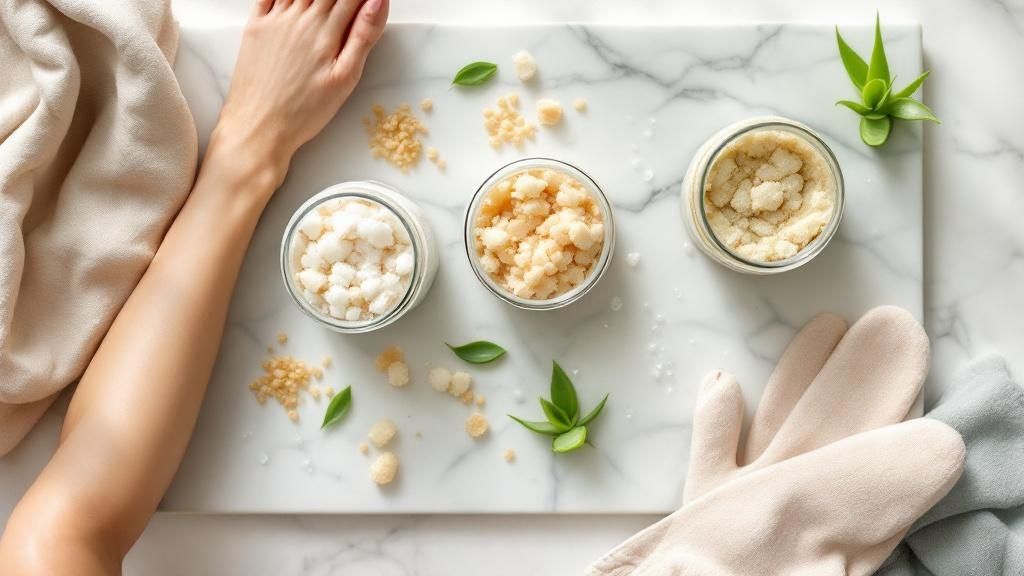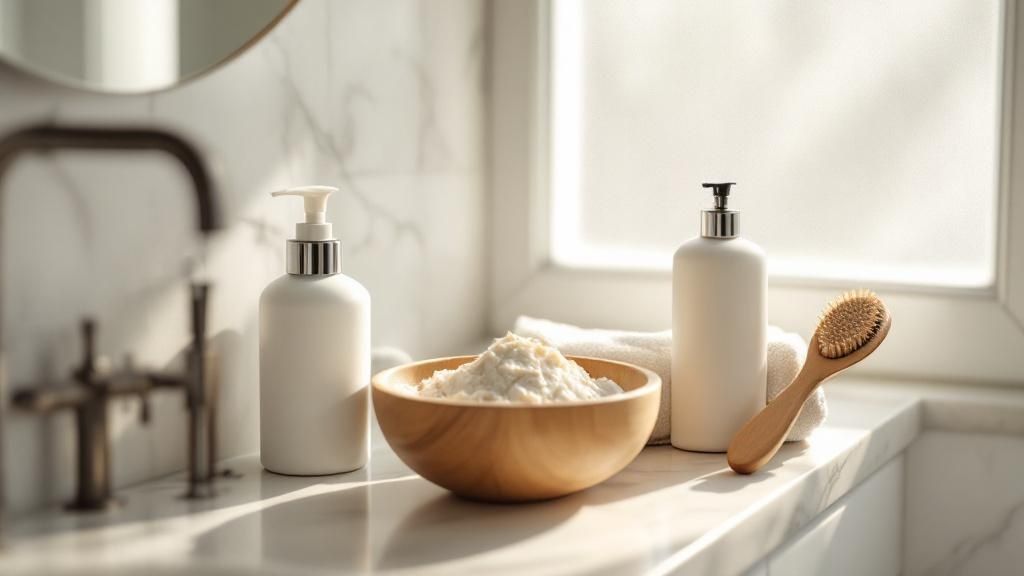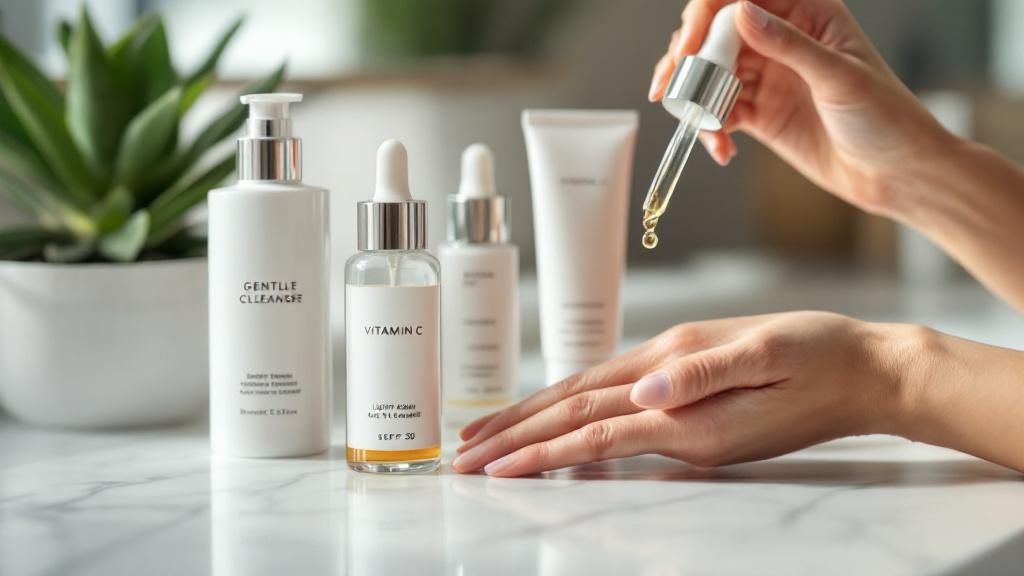
Top Skincare for Oily Acne Prone Skin | Clearer, Shine-Free Results
The secret to managing oily, acne-prone skin isn't about attacking it with harsh products. It's about finding a smart balance between deep, effective cleansing and providing the right kind of hydration. The goal is to get control over oil and breakouts by using targeted ingredients like salicylic acid and niacinamide, all without compromising your skin's natural moisture barrier.
So, Why Is Your Oily Skin So Prone to Acne?
Getting a handle on your skin starts with understanding why it acts the way it does. The link between that extra oil (sebum) and those frustrating breakouts is pretty direct, but what’s actually causing all that oil in the first place is often more complicated than just a shiny forehead.
Think of it as a cycle. First, your skin produces far too much sebum. That excess oil then mixes with dead skin cells that haven't been properly exfoliated, creating a sticky plug that clogs your pores. This congested, airless environment is the perfect place for acne-causing bacteria to thrive, leading to inflammation and breakouts.
But this oil overproduction doesn't just happen randomly. There are a few key culprits responsible for sending your oil glands into overdrive.
The Real Triggers Behind Excess Oil
First and foremost, you might have your parents to thank. Genetics play a huge part, so if they dealt with oily skin, chances are you will too. Hormonal fluctuations are another massive factor. You've probably noticed breakouts flare up during puberty, around your menstrual cycle, or when you're under a lot of stress. That's no coincidence—it's driven by hormones called androgens that directly stimulate your sebaceous glands to produce more oil.
Your environment also has a say. Living in a hot, humid climate like Egypt naturally ramps up sweat and oil production, leaving your skin feeling greasier and making clogged pores a constant battle. This is a common struggle here, and it's reflected in the market. In fact, the Egypt skincare market is growing steadily, projected to expand at a rate of 5.13% annually from 2025 to 2033. This growth is largely fuelled by a younger generation becoming more aware of how to care for their skin, especially when it comes to oiliness and acne. You can learn more by reading about these emerging skincare trends and market growth.
A Pro Tip From Experience: Your goal should never be to get rid of oil completely. Sebum is actually vital for protecting your skin and maintaining a healthy barrier. The real aim of a good skincare routine is to balance oil production, not strip your skin dry.
Oily vs. Dehydrated: Can It Be Both?
Here’s where so many people go wrong. One of the most common mistakes I see is misdiagnosing the skin's condition. You might think your skin is purely oily, but there's a good chance it's both oily and dehydrated.
This often happens when you use harsh, stripping cleansers or treatments in a desperate attempt to dry out the shine. Your skin panics. Stripped of its essential water content, it tries to compensate by producing even more oil to protect itself. This kicks off a frustrating cycle where your skin feels tight and flaky but looks shiny at the same time.
If you treat dehydrated skin as if it's just plain oily, you'll only make the problem worse. The solution is to reintroduce lightweight, water-based hydration while still gently managing the excess sebum.
Recognising the subtle differences is the key to picking products that will actually help. This comparison should help you pinpoint your skin's true needs.
Oily vs Dehydrated Skin Symptoms
Use this comparison to correctly identify your skin's true condition and stop making common treatment mistakes.
| Symptom | Truly Oily Skin | Oily and Dehydrated Skin |
|---|---|---|
| Feeling | Greasy, slick all over, rarely feels tight. | Feels tight, rough, or flaky, yet looks shiny. |
| Pore Size | Pores look enlarged and visible everywhere. | Pores are visible, but the skin surface can have dry patches. |
| Appearance | Consistent shine that builds throughout the day. | A shiny T-zone but dull, lacklustre cheeks. |
| Makeup | Makeup seems to "slide off" or melt away quickly. | Makeup looks patchy, clings to dry spots, and separates. |
Once you understand whether your skin is truly oily or also dehydrated, you can start building a routine that gives it exactly what it needs to look and feel its best.
Your Daily Morning Skincare Routine
Your morning routine is your daily defence. It's all about protecting your skin from the day's environmental stresses while getting that persistent shine under control. Think of it as suiting up your skin for battle, creating a shield that keeps it balanced, hydrated, and blissfully shine-free. Getting this right is the foundation of any good skincare plan for oily, acne-prone skin.
This doesn't have to be some complicated, 12-step ordeal. Honestly, a simple, consistent approach with the right products is far more effective. The goal is straightforward: cleanse gently, tackle issues with a smart serum, hydrate lightly, and always, always protect from the sun.
Begin With a Gentle Cleanse
First thing's first when you wake up: wash your face. Overnight, your skin has been busy producing oil and shedding dead cells. A quick morning cleanse sweeps all that away, stopping the pore-clogging that leads to breakouts and creating a clean slate for your other products.
Now, resist the urge to scrub your face with something harsh that leaves it feeling "squeaky clean." I know it feels satisfying, but that tight sensation is actually a cry for help from your skin's protective barrier. When you strip it, your skin panics and produces even more oil to compensate. Instead, reach for a gentle, pH-balanced gel or foam cleanser.
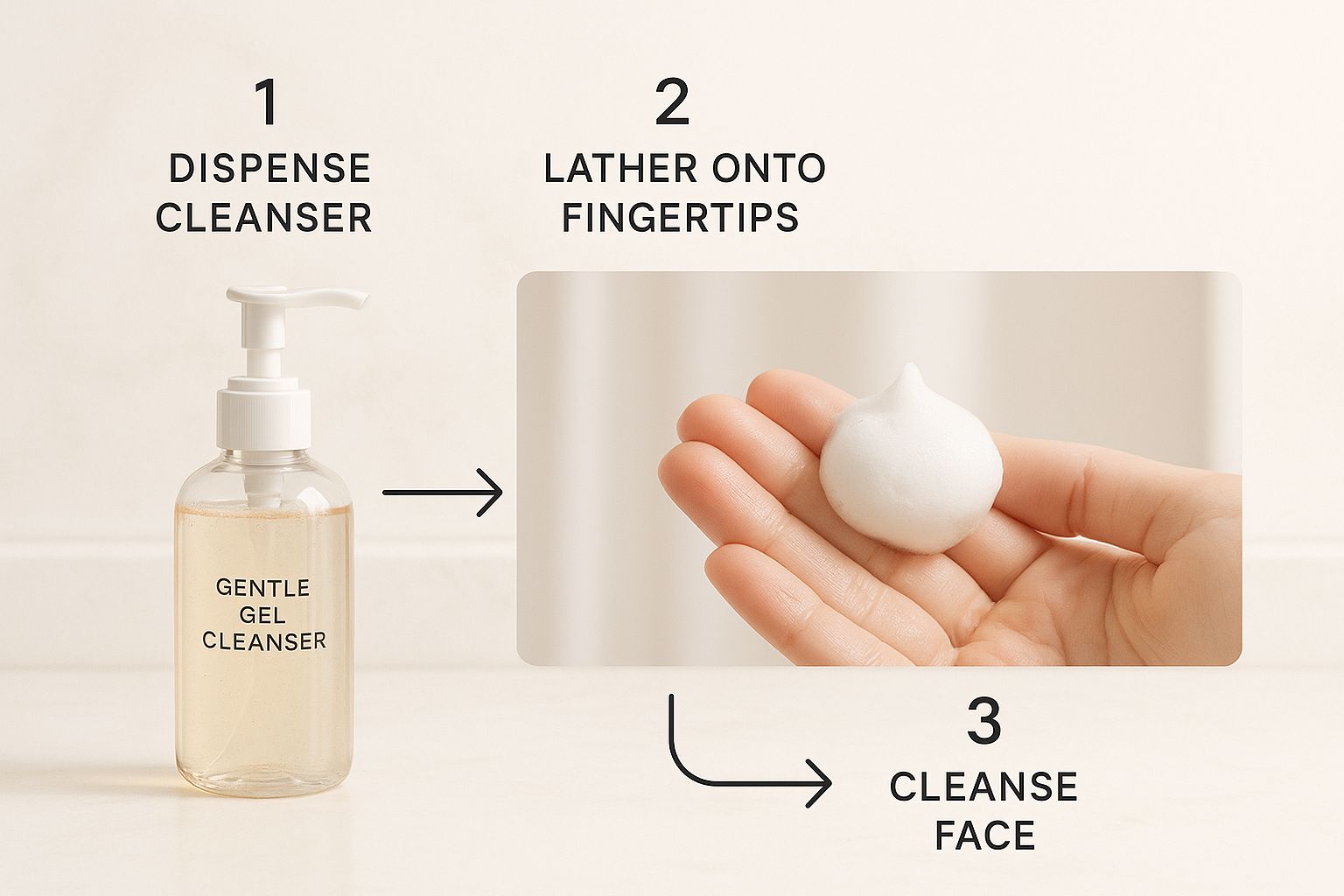
As you can see, a small amount of a targeted cleanser is all it takes to purify your skin without causing irritation. Look for formulas with ingredients like zinc PCA or mild cleansing agents that get rid of excess oil without disrupting your skin’s natural harmony. For a fantastic option that ticks all these boxes, the La Roche-Posay Effaclar Foaming Cleansing Gel is a cult favourite for a reason—it’s powerful yet incredibly gentle.
Add an Antioxidant Serum
Once your skin is clean and patted dry, it's time for a targeted serum. In the morning, an antioxidant serum is your absolute best friend. Why? Because antioxidants, like Vitamin C, are little bodyguards for your skin cells. They neutralise damage from free radicals—nasty unstable molecules from pollution and UV rays that cause inflammation, breakouts, and premature ageing.
For oily and acne-prone skin, a lightweight, water-based Vitamin C serum is the way to go. It’s also a superstar at fading those stubborn post-acne marks by helping to even out your skin tone over time.
Beyond Vitamin C, a serum with niacinamide is a game-changer. Niacinamide is a true workhorse for oily skin: it helps regulate oil production, strengthens the skin barrier, calms redness from breakouts, and can even make your pores appear smaller.
Hydrate With an Oil-Free Moisturiser
Let's clear up one of the biggest myths in skincare: oily skin does need a moisturiser. In fact, skipping it is one of the worst things you can do. When your skin gets dehydrated, it goes into overdrive, pumping out even more oil to try and moisturise itself.
The secret is simply choosing the right kind of moisturiser. You need something that delivers a dose of hydration without adding extra oil or clogging your pores.
- Look for "oil-free" and "non-comedogenic" on the label. This is your non-negotiable starting point.
- Opt for gel-creams or water-based lotions. These textures feel incredibly light and sink in quickly.
- Hunt for ingredients like hyaluronic acid. This clever humectant pulls moisture into the skin, giving you that plump, hydrated feel without any greasiness.
Finish With a Lightweight Sunscreen
If you only do one thing for your skin in the morning, please let it be applying sunscreen. Sun exposure doesn't just increase the risk of skin cancer and speed up ageing; it also makes post-acne marks darker and causes them to hang around for months longer than they should.
I get it—the thought of slathering another layer on oily skin can be a turn-off. But today's formulas are a world away from the thick, greasy sunscreens we grew up with.
Look for a broad-spectrum sunscreen with at least SPF 30. The key is to find a lightweight, "dry touch" or "matte finish" formula made specifically for oily skin. These are often fluid or gel-based and won't leave you looking shiny or feeling sticky. This is your most important step. Your morning routine is your primary line of defence, and sunscreen is its most valuable soldier.
Your Nighttime Routine for Skin Repair and Treatment
If your morning routine is all about defence, think of your evening routine as your repair crew. While you sleep, your skin is in full-on regeneration mode. This makes it the absolute best time to apply those powerful, targeted ingredients that go to work on breakouts, clear out clogged pores, and refine your skin's texture. Your nighttime ritual is all about washing the day away and letting your treatments do their thing.
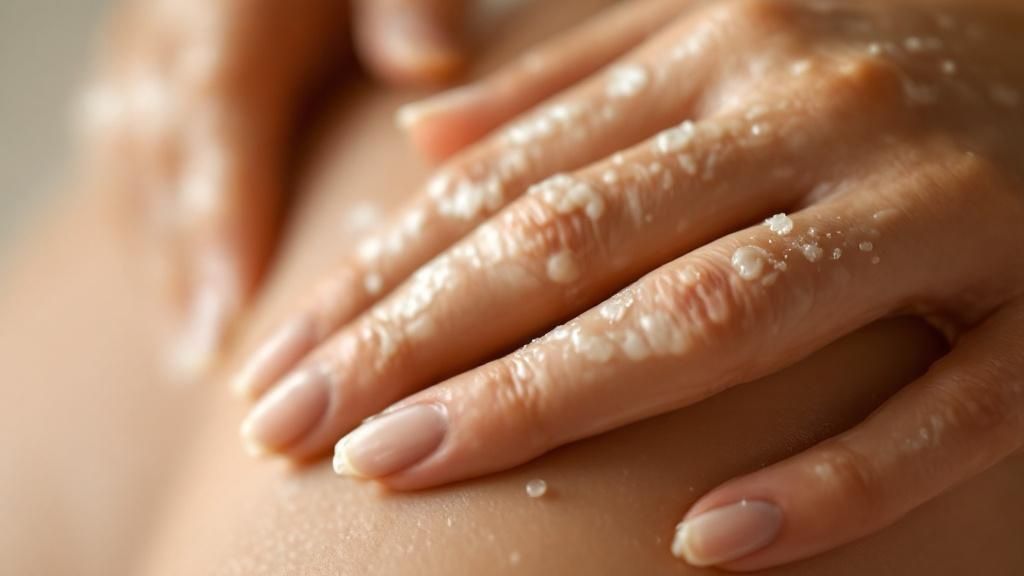
A smart nighttime routine for oily, acne-prone skin doesn’t need to be overcomplicated, but every step has a purpose. From dissolving daily grime to encouraging new, healthy skin cells, this is how you wake up to a calmer, clearer complexion.
The Power of the Double Cleanse
Let's be real: if you wear makeup or sunscreen, one wash just won't cut it. Throughout the day, a stubborn film of oil-based impurities—like your SPF, foundation, and even your skin's own excess oil—settles on your face. A regular water-based cleanser alone just can't break all of that down.
This is exactly why we double cleanse. It's a simple, two-step method that gets everything off without stripping your skin.
-
First, an Oil-Based Cleanse: Start with an oil cleanser or a cleansing balm on dry skin. Really massage it in. The oil in the cleanser grabs onto the oil on your face, dissolving makeup, sunscreen, and that surface-level sebum. Add a splash of water, and it will turn milky and rinse away clean.
-
Second, a Water-Based Cleanse: Now, follow up with your gentle gel or foam cleanser. This second wash whisks away any leftover residue from the first cleanse, plus any water-based gunk like sweat and dirt. Your pores are now perfectly prepped for what comes next.
Introduce Targeted Active Treatments
With a truly clean canvas, your skin is ready to soak up the ingredients that will do the heavy lifting overnight. This is when you bring out your exfoliants and cell-turnover boosters. A word of caution, though: always introduce these powerful products slowly to avoid irritating your skin.
Deep Clean Pores with a Chemical Exfoliant
For oily and acne-prone skin, a Beta Hydroxy Acid (BHA), specifically salicylic acid, is your best friend. While other acids work mainly on the skin's surface, salicylic acid is oil-soluble. This special property lets it dive deep into your pores to break up that stubborn mix of sebum and dead skin cells that causes blackheads and pimples.
Expert Tip: Start by using a BHA product 2-3 times per week at night, right after cleansing. Apply it, wait a minute or two for it to sink in, then move on to your next step. As your skin gets used to it, you might be able to use it more often.
Boost Cell Turnover with a Retinoid
Retinoids are the gold standard for a reason—they're incredibly effective for managing acne and improving skin's overall health. They work by speeding up your skin's cell turnover cycle. This helps to keep pores from getting clogged, stops new breakouts from forming, and can even help fade the dark marks left behind by old spots.
There’s a whole family of retinoids, from gentle over-the-counter retinol to much stronger prescription options like tretinoin. If you're new to the game, start slow.
- Go for a low concentration (think 0.25% or 0.5% retinol).
- Use only a pea-sized amount for your whole face, just once or twice a week to begin with.
- Try the "sandwich" method: Apply a light layer of moisturiser, let it absorb, apply the retinoid, and then seal it in with another layer of moisturiser. This acts as a buffer and really helps minimise irritation.
You have to be patient here. It can take a good 8-12 weeks to see real, noticeable changes from a retinoid, but the long-term payoff for clearer, smoother skin is absolutely worth the wait.
Never Skip Your Nighttime Moisturiser
After putting potent active ingredients on your skin, following up with a moisturiser is non-negotiable. Treatments like BHA and retinoids can be quite drying, and a good moisturiser is essential for supporting your skin barrier, locking in hydration, and calming any potential irritation.
Look for a formula that feels nourishing but is guaranteed not to clog your pores. An oil-free, non-comedogenic gel-cream or a lightweight lotion is perfect. Ingredients like ceramides, hyaluronic acid, and niacinamide are brilliant for putting moisture back and calming inflammation without feeling greasy.
This final step makes sure your skin's repair processes are fully supported, so you can wake up to a face that feels balanced and refreshed. This focus on targeted products is a major trend across Egypt, particularly with younger generations. Millennials and Gen Z are a huge driving force in the market, actively searching for products to manage oily and acne-prone skin. Being tech-savvy and influenced by social media, this demographic has made effective solutions like oil-free moisturisers and salicylic acid cleansers incredibly popular. You can check out more Egyptian beauty market trends on marknteladvisors.com to see the full picture.
Decoding the Label: Ingredients That Truly Work for Oily, Acne-Prone Skin
Ever feel like you need a chemistry degree to understand a skincare label? You're not alone. The world of active ingredients can seem incredibly complex, but here's the secret: you only need to know a handful of key players to start making smart choices for your oily, acne-prone skin.
Think of these ingredients as specialists on your team. Some are the heavy lifters, tasked with deep cleaning your pores. Others are the peacekeepers, calming down inflammation and keeping oil in check. Once you understand their roles, you can build a routine where every product works together to bring your skin back into balance.
The Pore-Clearing Powerhouses
When you're fighting active breakouts and trying to prevent new ones from forming, some ingredients are simply non-negotiable. These are the ones that get deep into your pores to stop trouble before it even starts.
-
Salicylic Acid (BHA): This is the undisputed champion for oily skin. As a Beta Hydroxy Acid, salicylic acid is oil-soluble. That means it can dive right into your pores and dissolve the gunk—that sticky mix of sebum and dead skin—that causes blackheads and pimples. Look for a concentration of 0.5% to 2% for an effective treatment that isn't too harsh.
-
Benzoyl Peroxide: If you’re seeing red, inflamed pimples, this is your go-to. Benzoyl peroxide is brilliant because it kills the specific bacteria responsible for acne, both on the surface and within your pores. It’s available in strengths from 2.5% to 10%, but I always recommend starting low and slow to see how your skin reacts and avoid unnecessary dryness.
-
Retinoids (like Retinol): This Vitamin A derivative is a true multi-tasking hero. It works by accelerating your skin's natural cell turnover process, which is just a fancy way of saying it helps shed old skin cells before they can clog your pores. With consistent use, retinoids also work wonders on smoothing out skin texture and fading those stubborn dark marks that pimples leave behind.
The Balancing and Soothing Brigade
While the powerhouse ingredients above are busy fighting acne, you need a solid support crew. These ingredients are all about keeping your skin happy, hydrated, and calm. They help regulate oil and soothe the redness that so often comes with breakouts.
Niacinamide: The Ultimate Regulator
Niacinamide, a form of Vitamin B3, is a superstar for anyone with an oily complexion. Its main claim to fame is its ability to help regulate your skin’s sebum production. Over time, this means you’ll notice less grease and shine. It also does a fantastic job of strengthening your skin’s natural barrier, calming inflammation, and even making large pores look smaller. It's a gentle giant you'll find in everything from serums to moisturisers, and it gets along with almost every other ingredient.
For a daytime product that tackles shine while giving you essential sun protection, a formula like the Eucerin DermoPurifyer Oil Control Fluid SPF30 is a great example of putting these principles into practice.
Clay and Natural Extracts
Don’t overlook the power of nature! Some of the most effective ingredients for managing oil and soothing irritation come straight from the earth.
Key Takeaway: The demand for natural solutions is undeniable. About 73% of skincare consumers in Egypt say they are willing to spend more on products made with natural ingredients. This shows just how much we value botanical extracts that can gently soothe and clarify acne-prone skin.
Here are a few natural standouts:
- Clay (Bentonite or Kaolin): Perfect for a weekly face mask. These clays act like magnets, pulling out excess oil, dirt, and impurities from deep within your pores. A clay mask once or twice a week is a simple, effective ritual to keep congestion under control.
- Green Tea: This antioxidant-rich extract is fantastic for calming down angry, inflamed skin. It helps reduce the redness associated with breakouts while protecting your skin from environmental stressors.
- Tea Tree Oil: Famous for its natural antibacterial properties, tea tree oil can be a potent spot treatment. A word of caution: it’s powerful stuff. Always use it diluted or in a professionally formulated product to avoid irritating your skin.
To make things even easier, here's a quick reference guide to the ingredients you should be looking for.
Hero Ingredients for Oily Acne-Prone Skin
This table breaks down the top ingredients to look for on a product label, what they do, and the specific concerns they're best at tackling.
| Ingredient | What It Does | Ideal For |
|---|---|---|
| Salicylic Acid (BHA) | Exfoliates inside the pore to dissolve oil & dead skin. | Blackheads, whiteheads, clogged pores. |
| Benzoyl Peroxide | Kills acne-causing bacteria. | Red, inflamed pimples (pustules). |
| Retinoids | Speeds up cell turnover & unclogs pores. | Preventing all types of acne, improving texture, fading marks. |
| Niacinamide | Regulates oil production & calms inflammation. | General oiliness, large pores, redness. |
| Clay (Kaolin/Bentonite) | Absorbs excess oil and impurities from pores. | Decongesting the skin, weekly deep cleanse. |
| Tea Tree Oil | Has natural antibacterial and anti-inflammatory properties. | Spot-treating individual pimples. |
By familiarising yourself with these key ingredients, you can finally walk down the skincare aisle with confidence. You'll know exactly what you're looking for and why, putting you firmly in control of your skin's health.
Lifestyle Habits That Make a Real Difference
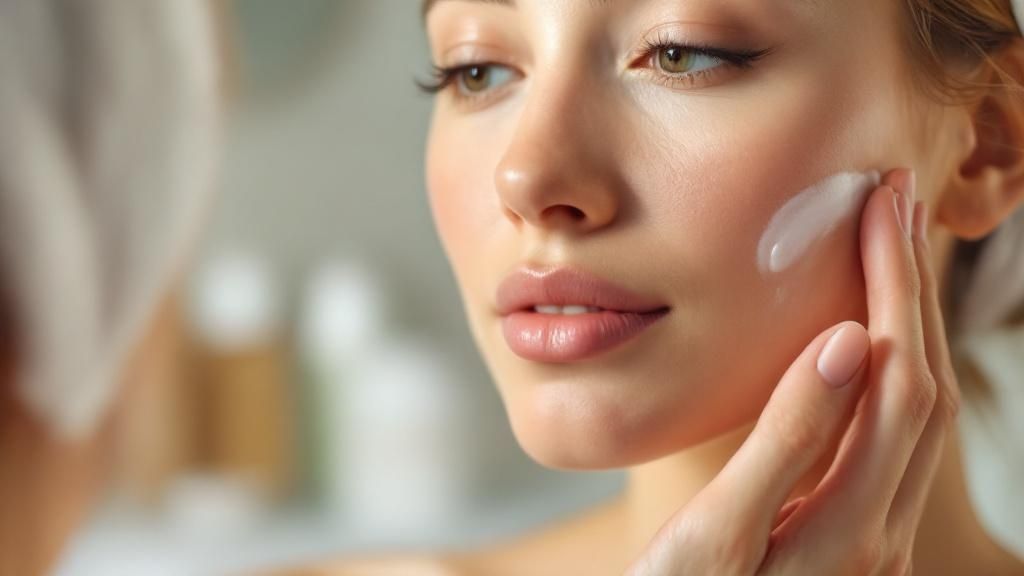 A fantastic skincare routine is your foundation, but what you do between cleansing and moisturising truly matters. Your daily habits can either work with you, supporting all your progress, or unknowingly sabotage it. Focusing on a few key lifestyle changes can be the missing piece of the puzzle, helping you manage oily, acne-prone skin from the inside out.
A fantastic skincare routine is your foundation, but what you do between cleansing and moisturising truly matters. Your daily habits can either work with you, supporting all your progress, or unknowingly sabotage it. Focusing on a few key lifestyle changes can be the missing piece of the puzzle, helping you manage oily, acne-prone skin from the inside out.
It’s these small, consistent efforts that really add up over time, leading to a dramatic improvement in your skin’s health and clarity. It all starts with realising that your skin is a direct reflection of your internal and external environment.
Adjusting Your Diet Mindfully
The connection between what you eat and how your skin behaves is a hot topic, but from experience, certain patterns are just hard to ignore. For many people, specific foods can trigger inflammation and ramp up oil production, which inevitably leads to more breakouts.
You don't need to jump into a super-restrictive diet. Instead, think of it as becoming a detective for your own body. Start to notice if your skin flares up after you've had a lot of sugary foods or drinks. These high-glycaemic foods cause your blood sugar to spike, which can set off a hormonal cascade that tells your skin to produce more sebum.
Similarly, some studies suggest a link between dairy (especially skim milk) and acne flare-ups in certain individuals. It might be worth trying to reduce your intake for a few weeks to see how your skin responds. It's all about mindful observation, not about depriving yourself.
Managing Stress to Control Oil
Ever notice a huge pimple popping up right before a big presentation or during a stressful week? That’s no coincidence. When you're stressed, your body pumps out cortisol, a hormone that, among other things, signals your oil glands to go into overdrive.
This extra oil creates the perfect environment for acne to thrive. Finding healthy ways to manage your stress isn’t just good for your mind—it’s a legitimate skincare strategy.
A Practical Insight: You can’t get rid of stress completely, but you can build small moments of calm into your day. This could be a five-minute breathing exercise when you feel overwhelmed, a short walk at lunchtime, or just putting on your favourite music. Consistent stress management helps keep those cortisol levels more stable, leading to more balanced, less reactive skin.
These simple, consistent practices can make a real, tangible difference in keeping breakouts at bay over time.
Overlooked Habits That Clog Pores
Sometimes, the biggest acne culprits are hiding in plain sight. I'm talking about those small, everyday habits that transfer bacteria and oil to your face without you even thinking about it.
Here are a few critical habits to start building now:
- Clean Your Phone Regularly: Your phone screen is a breeding ground for bacteria. Every time you hold it to your cheek for a call, you’re pressing that grime right into your skin. Give it a daily wipe with an antibacterial cloth.
- Wash Makeup Brushes and Sponges: Dirty makeup tools don’t just make for a streaky application; they re-apply old oil, dead skin cells, and bacteria back onto your clean face. Make it a habit to wash them at least once a week.
- Choose "Non-Comedogenic" Makeup: Always check that your foundation, concealer, and blushes are labelled non-comedogenic. This simply means they're formulated specifically not to clog your pores.
These tiny tweaks create a much cleaner environment for your skin, which significantly cuts down the chances of new breakouts. This kind of proactive approach is becoming more common, and it's fuelling major growth in the beauty world. In 2024, Egypt's beauty and personal care market hit a value of about USD 1,327.86 million and is projected to more than double by 2030. This boom is driven by consumers who are actively seeking effective, targeted solutions, both in stores and online. You can discover more insights about the Egyptian personal care market on marknteladvisors.com.
Common Skincare Mistakes You Might Be Making
https://www.youtube.com/embed/mayNQYlZ3p4
Even with a bathroom shelf packed with promising products, some common habits can quietly sabotage your journey to clearer skin. If you’re feeling frustrated by a lack of progress, it might be time to take a closer look at your daily routine. Recognising and correcting these missteps is often the key to finally unlocking the balanced, healthy skin you've been working towards.
One of the most frequent mistakes I see is getting too aggressive. It's so tempting to attack oily skin with the harshest, foamiest cleansers you can find, hoping to scrub the grease into submission. But this approach almost always backfires. That tight, “squeaky clean” feeling is actually a red flag; it means you’ve stripped your skin’s natural protective barrier. In a panic, your skin overcompensates by producing even more oil, locking you into a vicious cycle of shine and breakouts.
The Problem with Over-Exfoliating
Going overboard with exfoliation is another major issue. While active ingredients like salicylic acid are brilliant for clearing out pores, using them too often or in too high a concentration can lead to irritation, redness, and a damaged skin barrier. Think of your skin barrier as a security guard—it's essential for keeping moisture in and pollutants out. When it's compromised, your skin becomes much more vulnerable to inflammation and, you guessed it, more acne.
An irritated, over-stripped barrier can't heal or regulate itself properly. For oily and acne-prone skin, a gentle, consistent approach will always deliver better, more sustainable results than an aggressive one.
Another myth that needs busting is the idea that oily skin doesn't need moisturiser. This couldn't be further from the truth. When you skip this crucial step, you’re basically sending a dehydration signal to your skin. Its response? To ramp up oil production to protect itself. Always, always finish with a lightweight, non-comedogenic, oil-free moisturiser to give your skin the hydration it needs without clogging pores.
Impatience and Inconsistency
Finally, let's talk about the two biggest hurdles: inconsistency and impatience. Getting control of oily, acne-prone skin is a marathon, not a sprint.
A few habits that consistently hold people back include:
- Giving Up Too Soon: It can take a solid 6-8 weeks for active ingredients to truly show what they can do. If you're swapping products every other week, you're not giving anything a fair chance to work.
- Picking at Blemishes: I know it's incredibly tempting, but picking at pimples just pushes bacteria deeper into the pore. This only increases inflammation and leads to stubborn scars and dark spots that can hang around for months.
- An Inconsistent Routine: Skipping your nighttime cleanse or forgetting sunscreen for a day might seem minor, but these little lapses add up and undermine all your hard work. For those wanting to lock in that consistency, adding a targeted product like the La Roche-Posay Effaclar Anti-Blackheads Lotion after cleansing can really help refine your pores and solidify your routine.
By sidestepping these common pitfalls, you create the right environment for your carefully chosen products to perform at their best. Real progress comes from building a smart, patient, and consistent routine that supports your skin’s long-term health instead of constantly fighting against it.
Got Questions? We’ve Got Answers
Figuring out the right approach for oily and acne-prone skin can feel like a maze. Let’s clear up some of the most common questions I get asked, so you can build your routine with total confidence.
How Long Until I See Results?
This is probably the number one question on everyone's mind. While we all wish for an overnight fix, skincare is truly a marathon, not a sprint. You might start to notice your skin feeling less greasy or looking a bit clearer within a week or two, which is always a great feeling.
But when it comes to tackling acne, you have to play the long game. For active ingredients like salicylic acid or retinoids to really show what they can do, you're looking at about 6-8 weeks of consistent use. That's how long it typically takes to see a real reduction in breakouts and a smoother texture. The magic word here is consistency. Stick with it!
Can I Really Use Facial Oils on Oily Skin?
I know, it sounds completely backward. But yes, you absolutely can—as long as you pick the right ones. The common fear is that putting oil on oily skin will just clog pores and create more shine, but certain oils can actually help restore balance.
It's a surprising fact for many, but the right facial oil can send a signal to your skin that it's hydrated enough, helping it to slow down its own oil production. The goal is to find harmony, not to strip your skin of every last drop of moisture.
The key is to look for oils specifically labelled as “non-comedogenic,” which simply means they won’t clog your pores. Some of my favourites for oily skin are:
- Jojoba oil: Its molecular structure is incredibly similar to our skin’s natural sebum, which helps trick the skin into producing less.
- Squalane oil: This one is super lightweight, absorbs beautifully, and provides hydration without a hint of grease.
- Rosehip oil: An amazing choice if you’re also dealing with the stubborn red marks or scars that acne leaves behind.
A little goes a long way. Just press a few drops into your skin as the very last step in your nighttime routine.
Should My Routine Change With the Seasons?
Definitely. Your skin doesn't exist in a vacuum, and the weather plays a huge role in how it behaves. During the hot, humid summers we get in Egypt, you'll want to switch to lighter textures across the board. Think refreshing gel cleansers and airy, water-based moisturisers that sink in instantly.
Then, when the weather cools down and becomes drier, your skin can easily get dehydrated. This is a sneaky one because dehydrated skin often overcompensates by producing even more oil. In these months, you might want to swap in a slightly more nourishing (but still oil-free) cream to keep that all-important moisture barrier strong and healthy.
Ready to put together a routine that finally works? lo.la has a handpicked selection of authentic skincare designed to tackle the unique challenges of oily, acne-prone skin. Explore our collection and find your perfect match today!










